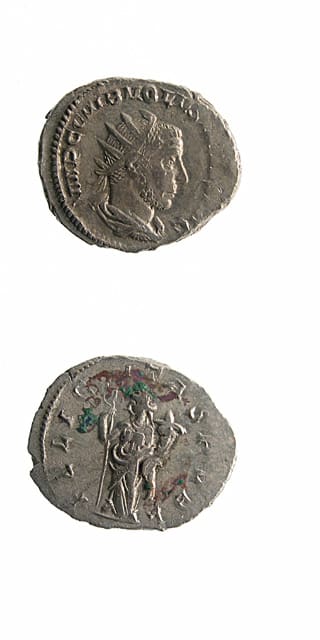Silver Antoninianus of Emperor Volusian, 251 CE - 253 CE
Silver
C.4917
Obverse: IMP C C VIB VOLVSIANVS AVG; Radiate and Draped Bust of the Emperor Facing Righ Reverse: FELICITAS PVBL; Felicitas Standing to the Left, Holding a Caduceus and a Cornucopia...
Obverse: IMP C C VIB VOLVSIANVS AVG; Radiate and Draped Bust of the Emperor Facing Righ
Reverse: FELICITAS PVBL; Felicitas Standing to the Left, Holding a Caduceus and a Cornucopia
Gaius Vibius Afinius Gallus Vendumnianus Volusianus was born in 230 A.D., the son of Emperor Trebonianus Gallus. He was named Caesar upon the accession of his father in June of 251 A.D. That same year, in November, he was elevated to the rank of Augustus, either just before or after the death of Hostilian. Both Volusian and his father were murdered in May of 253 A.D., by mutinous troops who supported a different contender for the throne: Aemilianus.
How many hands have touched a coin in your pocket or purse? What eras and lands have the coin traversed on its journey into our possession? As we reach into our pockets to pull out some change, we rarely hesitate to think of who might have touched the coin before us, or where the coin will venture to after it leaves our hands. More than money, coins are a symbol of the state that struck them, of a specific time and location, whether contemporary currencies or artifacts of a long forgotten empire. This stunning hand-struck coin reveals an expertise of craftsmanship and intricate sculptural detail that is often lacking in contemporary machine-made currencies. This ancient coin is a memorial to an emperor’s brief reign passed from the hands of civilization to civilization, from generation to generation that still appears as vibrant today as the day it was struck.
Reverse: FELICITAS PVBL; Felicitas Standing to the Left, Holding a Caduceus and a Cornucopia
Gaius Vibius Afinius Gallus Vendumnianus Volusianus was born in 230 A.D., the son of Emperor Trebonianus Gallus. He was named Caesar upon the accession of his father in June of 251 A.D. That same year, in November, he was elevated to the rank of Augustus, either just before or after the death of Hostilian. Both Volusian and his father were murdered in May of 253 A.D., by mutinous troops who supported a different contender for the throne: Aemilianus.
How many hands have touched a coin in your pocket or purse? What eras and lands have the coin traversed on its journey into our possession? As we reach into our pockets to pull out some change, we rarely hesitate to think of who might have touched the coin before us, or where the coin will venture to after it leaves our hands. More than money, coins are a symbol of the state that struck them, of a specific time and location, whether contemporary currencies or artifacts of a long forgotten empire. This stunning hand-struck coin reveals an expertise of craftsmanship and intricate sculptural detail that is often lacking in contemporary machine-made currencies. This ancient coin is a memorial to an emperor’s brief reign passed from the hands of civilization to civilization, from generation to generation that still appears as vibrant today as the day it was struck.



